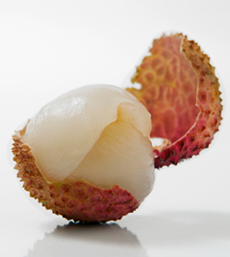TIP OF THE DAY: Learn About Lychee
|
Fresh lychee (pronounced LIE-chee, not LEE-chee, after the Cantonese lai chi) is now coming into season. Take the time to seek out this wonderfully exotic fruit. Delicately sweet, beautifully aromatic and very juicy, this subtropical fruit is native to Southeast Asia.
The small fruits, up to 1.5 inches in diameter, have a thin skin that is light pink to deep red in color. Inside is a translucent white fruit—in our opinion, one of the delights of the fruit kingdom. Lychee is also known as a Chinese Cherry, although it’s not related to the cherry—the lychee tree is an evergreen. It’s also called a lychee nut, but it’s not a nut: It gets that name from its large pit, which looks like a nut. That’s also why it’s called a Chinese cherry—after you enjoy the succulent fruit, you need to dispose of the pit. |
 A fresh lychee. Photo by A.R. Nowsser | CSP. |
|
|
You’ll also find alternative spellings, such as litchi and litchee. If you can’t find fresh lychees locally (look in produce specialty stores and Asian markets), you can buy them online from Melissa’s. There are also:
Lychees are a good source of vitamin C and phosphorus. They should not be peeled until just before they are served. Remove the peel and the black pit (seed). When cooking with lychees, add them at the last minute to maintain the most flavor and aroma. As lychees age off the vine, the reddish-pink color turns brown—still fine to eat, but a bit less moist. To keep lychees fresh, wrap them in a paper towel and store in a perforated plastic bag in the produce drawer. Time to plan a lychee martini party! |
||


